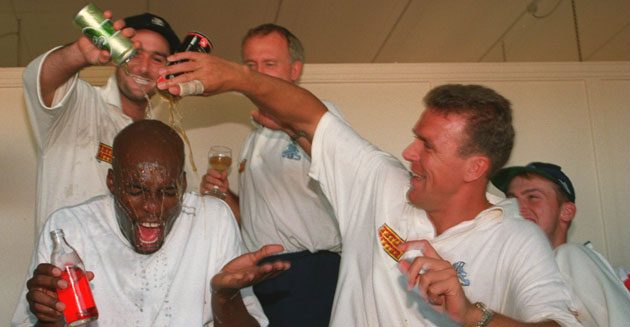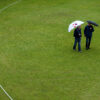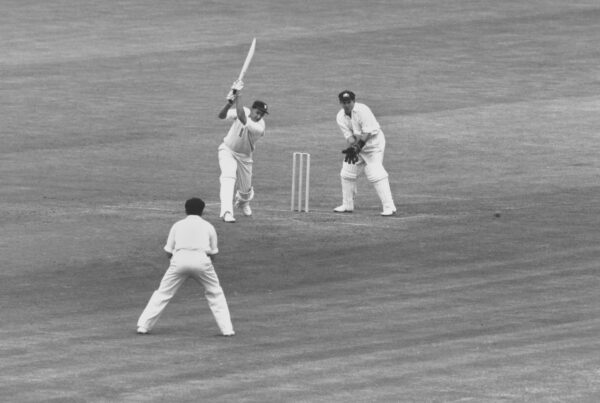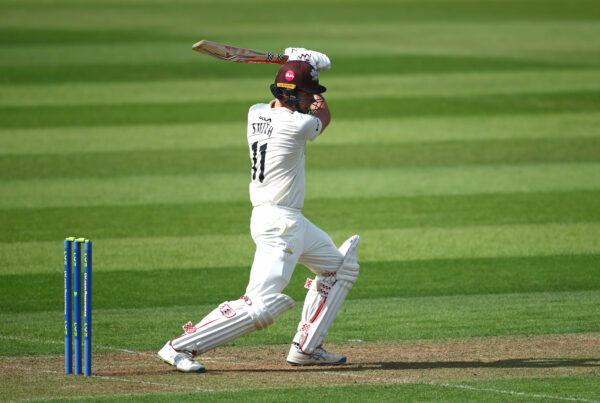Perhaps it’s no surprise that England feel more at home when they reach the Adelaide Oval.
Unlike stormy Brisbane, the climate is kinder and the South Australian state – which was established as a British province in February 1836 – would not feel out of place if you came across it in the United Kingdom.
Just across the boundary is St Peter’s Cathedral and although it’s less visible from much of the ground than was once the case, the large modern stands afford many spectators a greatly enhanced view.
19th century visits
England certainly took to the ground early. Their first visit in 1884-85 marked its international debut, in which the tourists won by eight wickets on the way to winning 3-2, and improved on that eight years later, when Surrey’s George Lohmann backed up Lancashire’s devastating left-arm spinner Johnny Briggs – who claimed 12 wickets in the match – by claiming six victims in an overwhelming victory by an innings and 230 runs. It was the only win in a series lost 2-1.
Adelaide became less welcoming after that. England lost their next five outings there, the first in 1894-95 by 382 runs despite Tom Richardson – county colleague Lohmann’s health was failing by then – claiming 5-75 and 3-89.
Fast bowler Richardson’s big-hearted qualities were in ample evidence in 1897-98, battling his way through 56 overs to take 4-164. But he could not prevent the hosts totalling 573 all out and England crumbled to 278 all out despite Tom Hayward stroking 70. When they were dismissed for 282 all out second time round, it meant a reversal by an innings and 13 runs.
Pre-war years, including Hobbs & Bradman
Hayward renewed acquaintance with the Oval by making 90 in 1901-02, launching the match by putting on 149 with skipper Archie MacLaren on the way to 388 all out but it could not save them from a four-wicket defeat. And on his next trip two years later, 67 in the first innings failed to avert a 216-run setback in a series lost 4-1.
Jack Crawford’s brief Test career – one of the most talented all-rounders of his age had two spells at Surrey and played just 12 times for his country – included a fighting 62 in the 245-run trouncing in 1907-08 on another difficult tour.
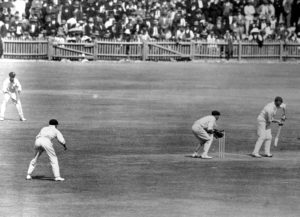
Jack Hobbs played only a fringe role in that match but when England returned in 1911-12 he relished the occasion. Australia had been dismissed for 133 and ‘The Master’ eclipsed that on his own, hitting 187 out of 501 all out. Although the hosts did much better second time round with 476, it set up victory by seven wickets and the tourists went on to claim a 4-1 success.
England were not to return until the winter of 1920-21, once international cricket had resumed after the First World War, and they suffered a 5-0 whitewash. Adelaide hosted the third match, where the tourists were set 490 to win and Hobbs made 123 in a defeat by 119 runs, the final man out his county colleague Percy Fender for 42. A third Surrey player, Herbert Strudwick, kept wicket.
Returning four years later was only marginally more successful – losing 4-1 – and the defeat at Adelaide came by 11 runs. Hobbs even had a rare bowl, albeit only three overs, in Australia’s mighty 489 all out and then batted down the order to make 119.
Hobbs would have enjoyed the irony when England turned the tables to win by 12 runs in 1928-29, Percy Chapman’s men relishing a 4-1 triumph, his 74 in the first innings complemented by fellow Surrey man Douglas Jardine’s 98 in the second.
Hobbs was a spectator – albeit a working one – when the 1932-33 series exploded in Adelaide. Led by Jardine, England’s ‘Bodyline’ tactics, although the captain insisted on ‘leg theory’, were designed to target the bodies of the home batsmen and contain the prolific Don Bradman. When Bill Woodfull and Bert Oldfield suffered serious blows from Harold Larwood, it almost resulted in a riot and diplomatic relations between the two countries were strained. Not that Jardine cared much, his side winning the match by 338 runs and series 4-1 plus the Ashes back with them.
Bradman was to gain his revenge, many times over, not least in the double-century he scored in the 1936-37 Test there which saw Australia level the series and go on to claim a remarkable 3-2 win. Yet a decade later, he was to fall to a delivery which he described as “the best ball I ever faced”.
Post-war period, including Bedser, May & the spin twins
It was bowled by Alec Bedser, who had exploded on to the Test scene in 1946 when India became the first post-Second World War visitors to England and found the Surrey man’s command of swing and seam far too much for them in a damp summer.
Yet the following winter in Australia, he discovered the hard and true pitches offered little movement and the balls would not swing, the still inexperienced Bedser toiling with little success against a stellar batting line-up. He needed another weapon and developed it cutting his fingers across the ball to develop what was effectively a fast leg-spinner, a potent combination when twinned with his natural inswing.
Bradman was one of the first recipients, receiving a delivery which pitched on leg-stump and hit the top of off to depart for a nine-ball duck. It was the first of six occasions Bedser would take his wicket in a match which was drawn with the help of two Denis Compton centuries, although the series was lost 3-0.
Even Bradman’s retirement failed to change the balance immediately, England’s second post-war Ashes tour being lost 4-1, but in 1954-55 their 3-1 triumph centred around the fast bowling pair of Frank Tyson and Brian Statham. Despite losing the opener at Brisbane, wins at Sydney and Melbourne put them ahead and the Ashes – won back in 1953 – were retained through nervy five-wicket victory at Adelaide. Peter May’s runs were another key factor and when he departed for 26, as the tourists chased 94, the tourists stumbled to 49-4 before going on to success and secure the series.
May, one of Surrey’s finest post-war players, took over from Len Hutton soon after and led the defence of the Ashes in 1956, being hot favourites to make it four series in a row in 1958-59. But the tour went disastrously wrong and it was at Adelaide that the Ashes changed hands again as England were beaten by 10 wickets. May was not instinctively a gambler but at 2-0 down chose to insert the hosts, perhaps because his county colleague Jim Laker had been forced out with a damaged spinning finger, which left Oval spin twin Tony Lock as the sole spinner.
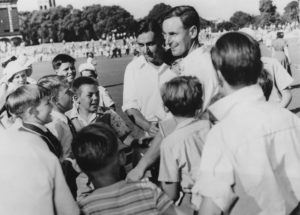
Australia’s 476 proved mighty, a lacklustre reply of 240 seeing England forced to follow on and May’s sterling 59 was unable to save his side.
Another county stalwart Ken Barrington enjoyed happier memories of the ground. England’s tour Ashes tours of the sixties failed to recover the Ashes – both finishing 1-1 – but Surrey’s middle-order maestro relished the South Australian air. His 63 in the first innings ensured the deficit was reduced to 62 and when they were set a nominal 356 in two sessions by Richie Benaud, Barrington’s unbeaten 132 secured an easy draw.
He only had to wait another three years and England arrived at the ground 1-0 ahead after three Tests. This time Barrington made 60 out of an unimpressive 241, Bobby Simpson’s double-century driving Australia to a hefty 516. Despite Barrington hitting 102 second time round, he could not prevent defeat by an innings and nine runs for Mike Smith’s men.
Edrich, Alam & the barren years
Maybe he passed on some tips to John Edrich, who cracked 130 out of 470 when Ray Illingworth’s side finally reclaimed the Ashes after a 12-year gap in 1970-71. Ahead after winning at Sydney, they totalled 470 and that was more than enough to secure a draw, drawing criticism for declining to enforce the follow-on.
Perhaps surprisingly, the only Surrey player to appear in a Test at the ground in the next two decades was Intikhab Alam, whose hard-fought 64 in the first innings could not prevent his Pakistan side being hammered by an innings and 114 runs in 1972-73.
Stewart & co against the all-conquering 90s Aussies
When that drought finally ended, in the Ashes series of 1990-91, it was less notable for Alec Stewart’s two innings (11 and 9) than him keeping for England for the first time in a run-rich match. A badly broken finger prevented him rejoining battle four years later but Graham Thorpe’s 83 in the second innings was key to the tourists winning by 106 runs, their first win in Australia for eight years.
Stewart was captain in the 1998-99 series, his side beaten 3-1 and the Ashes being retained by Mark Taylor and his men when they won the third Test at Adelaide by 205 runs, Stewart running out of support to finish unbeaten on 63 as the match slipped away. Playing alongside Mark Butcher, he chipped in with 57 when England suffered another trouncing – by an innings and 51 runs – as Steve Waugh’s men reigned supreme on the next visit in 2002-03.
Since then it’s been a tale of three defeats interspersed by England’s win by an innings and 71 runs in 2010-11 but after last week’s opening reverse at Brisbane, Joe Root and company badly need to rediscover their winning recipe at the Adelaide Oval.
